There are some fascinating facts to be extracted from the YouGov “Most Popular UK Beer and Cider Brands” survey for Q2 2022, not least the fact that James Watt, Beer Twitter’s most hated villain, runs one of the UK’s most popular craft beer brands right across the age spectrum, from 20-year-old Millennials to Baby Boomers in their 70s.
I extracted these tables from the mass of raw-ish data supplied by YouGov, using my own admittedly probably idiosyncratic idea of what a “craft beer” brand/brewer is, which I based on the way I suspect the great beer-drinking public would categorise the different brands in the survey. Thus Hobgoblin/Wychwood and Doom Bar are in there, because they WERE made by independent “craft” brewers once, and the same goes for Camden Town, Goose Island and Lagunitas. I would be astonished if the average British beer drinker, even the average British craft beer drinker, knows Goose Island is owned by the same company that brews Budweiser, or Heineken owns Lagunitas. Beer Twitter is a very elite bubble, remember.
I have also left out old-established family brewers because I suspect most British beer drinkers know who they are and don’t regard them as “craft”. Don’t argue with me about it. My gaff …
There are a few surprises in the lists – wot, no Meantime? Why so few German brands? – but I suspect this is a factor of the list of brands YouGov asked people about, which was very probably driven by the brands its clients asked to be included. That would explain why a number of obscurish (to me) US brands are in there. There are also quite a few total unsurprises, such as the way Baby Boomers go for traditional brands, and Millennials love ciders.
“Popularity” here is defined as the percentage of people who have a positive opinion of a beer or cider brand, and may well not, of course, reflect actual sales rankings.
Most popular craft beer brands among Millennials (aged 20 to 40)
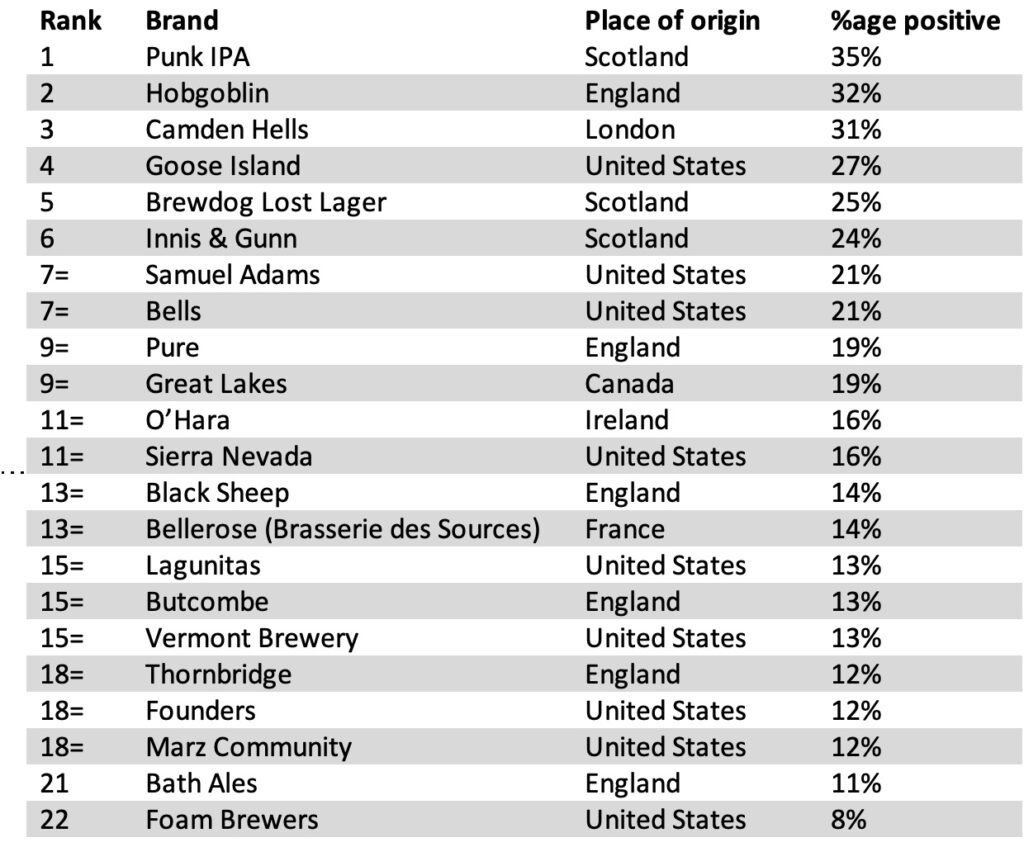
Nine of those brands are from the US, but some of the beers you really would expect to see (No Brooklyn? Really, YouGov?) are absent, and a couple of real obscurities (translation: I’ve never heard of them) make it in, Marz Community of Chicago and Foam Brewers of Vermont. Ten are from Britain, and one each from Ireland and France.
The list of Millennials’ top beers overall makes depressing if probably unsurprising reading, but a fascinating contrast with the lists of older drinkers:
Most popular beers overall among Millennials
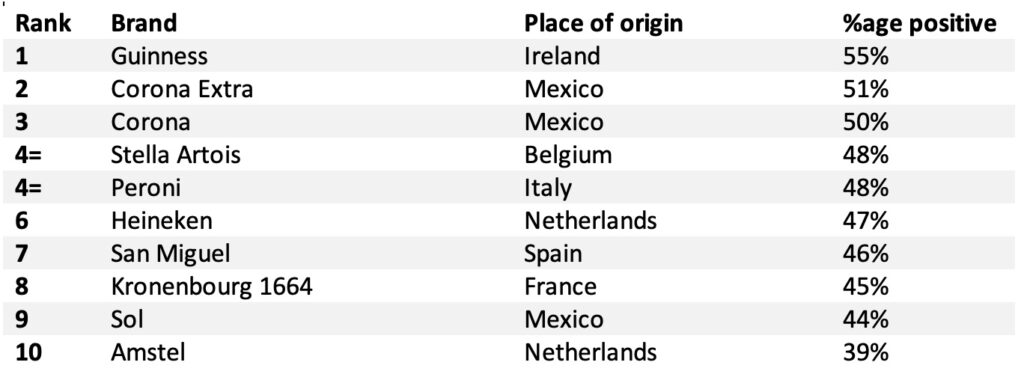
Not a single British brand among them, you’ll have spotted (yes, I know most of them are brewed in Britain, but you know what I mean). No Carling? No Carlsberg? Nope: both down at 31st place, with 31 [per cent approval, less than Punk IPA and Hobgoblin. Carling Cider is more popular than Carling lager among Millennials, at 33 per cent. I’m tempted to say “you don’t drink what your dad drinks,” but the presence of Stella and Heineken among the Millennials’ Top 10 suggests this is not totally true… Millennials also have four ciders in the top 10 drinks they are most positive about, with Kopparberg and Magners tying with Guinness on 55 per cent and Bulmers and Strongbow Dark Fruits just behind on 53 and 52 per cent respectively.
Most popular craft beer brands among Generation X (aged 41 to 58)
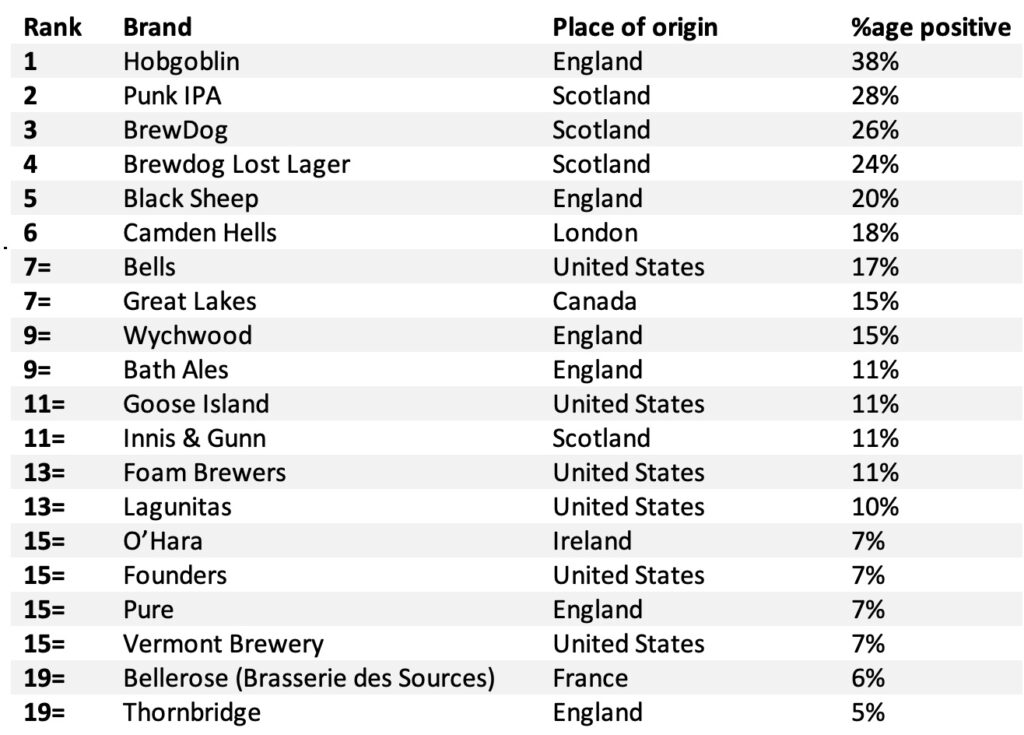
Interesting differences between Gen X and their younger sisters and brothers: this was the group that started drinking around 1983 and was hitting its stride in the early 1990s, when the “guest ale” was introduced, greatly benefitting breweries such as Wychwood and Black Sheep: does that explain those breweries’ greater popularity among Gen X compared to Millennials? BrewDog still puts on a good showing, as does Camden Hells, and there is that strange appearance by Foam and Vermont Brewery again, but Sam Adams disappears, for some reason: that was a late 1990s introduction to the UK market, I recall – it was the lager I chose for my wedding in 1997. It is also noticeable that with the exceptions of Hobgoblin, Black Sheep and Bath Ales, brands all score less among Gen X than they do among Millennials, so that Bath Ales, a mid-1990s start-up, with an 11 per cent positive rating in both tables, is the 10th most popular craft beer among Gen X drinkers but only 21st among Millennials.
Most popular beers overall among Generation X
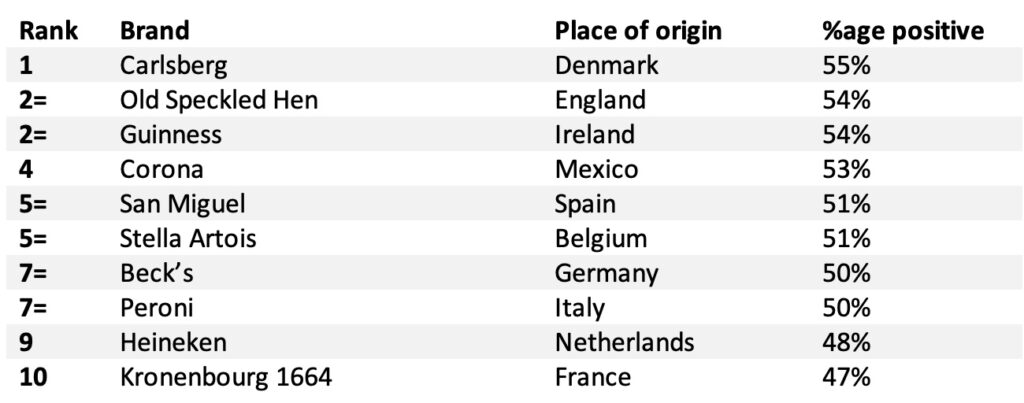
Whoa! There’s a cask beer in there at number two! Not that Beer Twitter will be impressed, la la, but still … And Carlsberg has bwoinged in straight to number one, vastly more popular among Gen X than among Millennials. Still no Carling in the Top Ten – that’s down at number 25, on a 35 per cent approval rating, less than Greene King IPA: less than Shandy Bass, even. It also appears that overall Gen X likes its big brands more than Millennials do, with an average approval rating for its top 10 of 51.3 per cent, against 47.3 per cent for Millennials’ top 10. Surprisingly, Sol has dropped out of the top 10, down at 14 and 43 per cent approval, while most other brands improved their percentages: Sol was THE yuppie beer brand of the mid-to-late 1980s. (Remember yuppies, people? Young upwardly-mobile professionals, worked in finance or marketing or advertising, always wore suits – men and women – drove around in a Volkswagen Golf GTi? They’re OIRish, many of them, today – old immobile retirees …) The overall table is actually topped by Kopparberg cider, at a 65 per cent positivity rating (why?), followed by Strongbow on 56 per cent, while Magners is 11th overall with 48 per cent.
Most popular craft beer brands among Baby Boomers (aged 59 to 76)
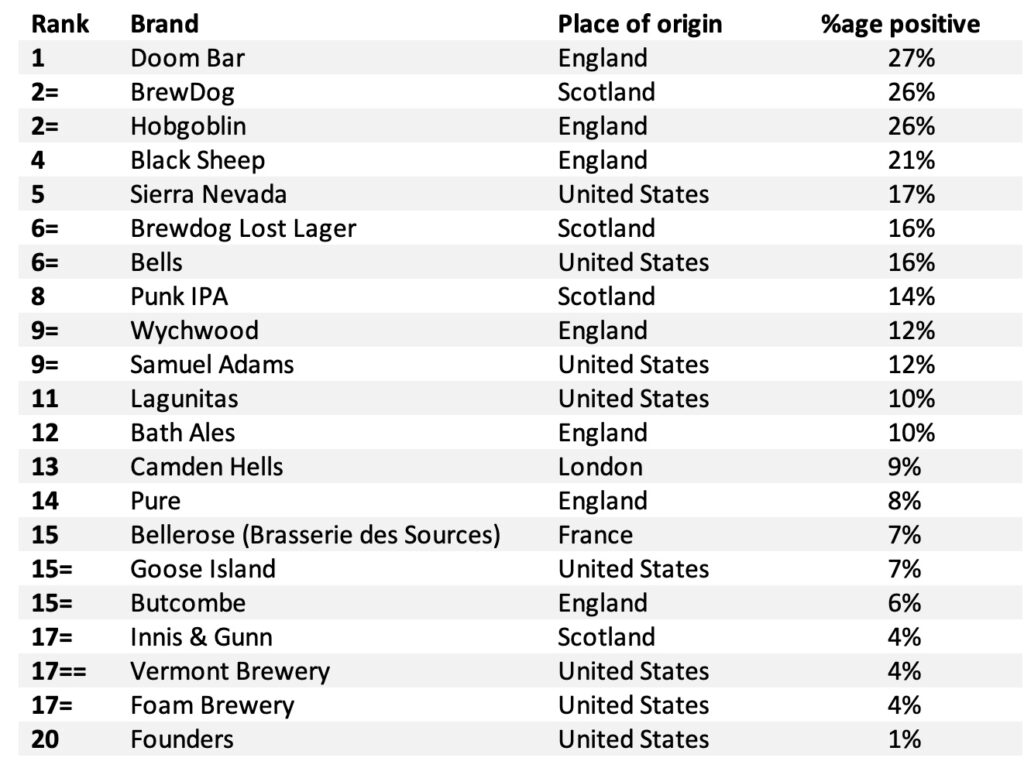
This is the generation that founded Camra, so it’s no shock that three of its top four craft beer brands are cask ales. Even so, it’s still fond of BrewDog, almost as much as Gen X, though rather less than Millennials. In all there are six cask brands in its top 20, more than any other generation manages, but it doesn’t like Camden Hells or Goose Island as much as younger drinkers. Nor does it like its favourite craft beers as much as younger drinkers like theirs, with an average score for the top 10 of just 18.7 per cent, against 25.4 per cent approval from Gen X for its top 10 and 21.2 per cent for Millennials. And those odd US brands are really not very popular at all. Mr and Mrs Boomer would rather stick to the familiar …
Most popular beers overall among Baby Boomers
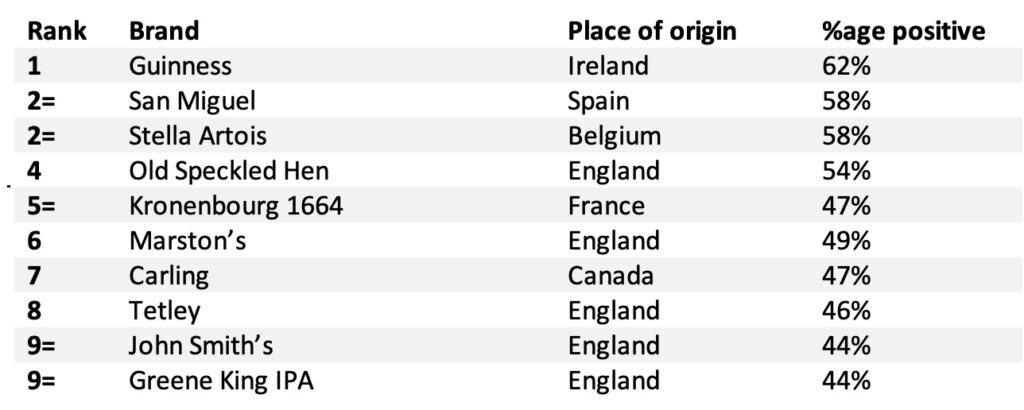
This is the Real Ale generation, with half its top 10 most favourite brands available as cask ales. It’s also the generation that likes Carling, which must worry the brand’s marketing managers: tens of thousands of its drinkers are dying every year, and not being replaced by younger cohorts. It doesn’t like Carlsberg that much though, unlike Gen X: 21st in the table, with 37 per cent popularity. Baby Boomers are positive about their big names more than Millennials but less than Gen X, with an average score of the top 10 of 50.9 per cent approval. Boomers are the only cohort without cider brands topping their overall top ten brands, with Strongbow on 50 per cent approval and Magners on 47 per cent. The love of San Miguel is a little curious: happy memories of package holidays to various not too costly Costas in Spain in their teens and twenties, perhaps? And the cross-generational love for Stella is also fascinating, with it and Guinness the only top five brands among all cohorts from 20 to 76. Why Stella? God knows … That high positivity for Guinness, too, number one or number two with everybody from young dude to grandparent, is intriguing: rivals have been trying to challenge the Irish monolith with their own stouts for more than 50 years, and nobody has got near yet.
What other conclusions can we draw? Well, certainly that the bad publicity BrewDog has been receiving about the alleged toxicity of its workplaces and the alleged appalling behaviour of its CEO does not seem to be having any effect on its popularity among beer drinkers across three generations, with all other “craft” beer brands bar Hobgoblin trailing behind in the popularity race. The figures also suggest that the shiny new giant bar the company has just opened at Waterloo Station in London is likely to be a success despite the outpouring of hatred on Beer Twitter, although the sight of James Watt with his baseball cap turned backwards is certainly enough to put off anyone from any generation: white men with their headgear reversed, imitating black rappers, looked stupid 30 years ago when it was first a phenomenon, and it looks just as stupid now. Still, is Watt bovvered? I suspect that, like Liberace 66 years ago, he is crying all the way to the bank.


“Wot no Meantime?”
I’m sure there are various reasons why Meantime is the ghost of a shadow of what it could/should have been, but one of them might be that, since acquiring it, Asahi UK has never had a clue what to do with it, or how to promote it.
You know, when an Asahi Area Sales Manager tells you, “They (ie sales staff) are not there to talk bollocks about hops, they’re there to sell brands”, that’s probably not a good sign regarding what was supposed to be a craft beer.
Wot no Magic Rock? no Dark Star?
Your rules etc, but I wish you had included “family” brewers – including Sharp’s in the “craft” category but excluding Adnams’ seems positively eccentric.
Can a beer (Brewdog) made in 3 breweries around the world and sold in every supermarket as part of multibuy offers still be considered “craft”?
The people who drink it almost certainly all regard it as a “craft” beer, so – yes.
I don’t like Punk IPA so not everybody and their grandad loves it. Nonsense slogan
You don’t know how journalism works, do you, Steve?
What is “Beer Twitter”?
It needs to be explained to the >75% of the population that don’t use twitter.
Of the 75% of thne popul;ation that don’t use Twitter, I suspect 99.999% don’t read my blog, so no, Beer twitter doesn’t need explaining.
Brewdog Punk IPA tastes nothing like it used to when it first came out in my opinion. I do believe that over time, and due to it’s popularity the recipe has changed somewhat. I’m really not a fan of it to be honest, there’s far better beer out there now and I’d question their credentials (has that term really been defined?) as a “craft brewer” considering their size.
They say the same about Jaipur. In reality, natural variability apart, its more a case of our tastes changing as a result of the hop assault that has taken place in the craft space in my opinion.
Being an American “weirdo”, I don’t have Twitter (or instagram or snapchat), and the only time I see things “on twitter” is when beer writers that I like write about something that was posted on Twitter. (Not always on beer either, but sometimes on beverages in general.) Does that make me in the .0001%, or no because I’m American and the population was UK specific? I am obviously only poking some fun. Since I am an American (weirdo might be redundant), I only get some of these beers from the UK in can or bottle. Are they available that way in the UK as well? You drew specific inferences to cask, and because I cannot get it that way, I was curious to know if it was available in stores to consumers in the UK in “other than draught” form? My main “complaint” (using a lot of “scare quotes” in this comment…) about the data, aside from what you mentioned as problematic, is that there seems to be a conflation with brand name and beer. When UK drinkers experience Sam Adams, Founders, Sierra Nevada, Bells, Goose, Lagunitas, &c, is it 99.999% of the time the flagship beer? In the USA, these breweries ship 31 flavors across the nation. (To use what I think is an Americanism – they’re all like Baskin Robbins to me and that is hard enough to choose from one brewer occasionally. Choice is good, if I have the intellect and will?) Aside from the strictly Yank perspective, I had wondered why have the brewery in a segment, followed by a beer from that brewery? Does that mean we should interpret that data as a conglomerate in some way? I can see some arguments for and against doing that. I guess, as an outsider/outlander, I’d be curious to know if it implies in the UK that they’re speaking of two different beers likely: Brewdog Punk IPA, vs. Brewdog Lager vs. other Brew dog beer, Wychwood Hobgoblin v. Other Wychwood brew. As usual, fascinated by your take and choices, without any real complaint, but more curiosity.